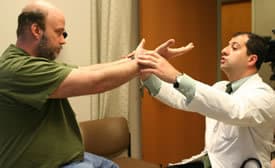New Device Unclogs Stroke Patient’s Veins in Brain
| In the days leading up to Glen Deaton’s emergency trip from Trumann to the University of Arkansas for Medical Sciences (UAMS), large veins that drain blood from his brain were clotting.
Confusion, nausea, vomiting and blurred vision were among his symptoms. An MRI revealed cerebral venous sinus thrombosis – a type of stroke caused by a clot that in Deaton’s case ran from the top of his head nearly to his neck. With the blood flow stopped like water in a clogged drain, tremendous pressure was on Deaton’s brain, resulting in the stroke and hemorrhage despite a shunt to relieve the pressure. He had a seizure, became unresponsive and had to be put on a ventilator.
Salah Keyrouz, M.D., a UAMS stroke neurologist and Deaton’s physician, described it as the worst case he had ever seen. “I didn’t think he was going to make it,” he said.

UAMS’ Salah Keyrouz, M.D., examines Glen Deaton six months after Deaton’s nearly fatal stroke.
Keyrouz called on UAMS’ Eren Erdem, M.D., director of interventional neuroradiology, and Mollie Atherton, M.D., interventional radiology fellow. Atherton and Erdem used a balloon catheter to try to break up the clot, but it was unsuccessful. Next they used the catheter to apply a powerful blood thinner, t-PA, right at the site of the clogged vein. That didn’t work either.
Their breakthrough came when they next tried a new catheter device that was acquired only months before by UAMS as part of a $2 million National Institutes of Health grant for research of new stroke treatments. Called EKOS, the device could deliver the t-PA at the site of the clot and vibrate it with ultrasound to help the blood thinner penetrate the clot.
As with the previous catheter attempts, Atherton and Erdem threaded the tiny device into a leg vein and all the way into the brain.
“I was amazed at how quickly it dissolved the clot,”Atherton said. “We were able to restore blood flow within about an hour.”

William Culp, M.D., is leading stroke research at UAMS with the EKOS machine, above, in Culp’s lab.
The next day Deaton, 42, awoke from his coma, and a few months later, he was nearly back to full strength.
It was the first time for the EKOS device to be used on Deaton’s type of stroke, and Erdem and Atherton have been invited to present the case to the Cardiovascular and Interventional Radiological Society of Europe at its September meeting in Portugal.
Deaton was admitted to UAMS on Jan. 9 and went home Feb. 5. Keyrouz recalled his amazement with Deaton’s recovery when he happened to bump into Deaton visiting a friend at UAMS about three months before his follow-up visit June 19. “I couldn’t believe he was doing that well.”
During the June office visit, Keyrouz explained of the seriousness of Deaton’s condition.
“We honestly didn’t think you were going to make it,” Keyrouz told him. “You had one of the most severe cases of blood clots in the veins in your brain.”
“I’m a little beside myself, thinking about how bad it was,” Deaton said. “I’m glad I came to UAMS, and I’m glad they could help.”
William Culp, M.D., who is leading the NIH-funded research of new stroke therapies at UAMS, said while the FDA-approved EKOS device was acquired for his research, he is glad to share it to treat patients when needed.
Culp credited the device as well as UAMS’ ability to provide a multidisciplinary approach to the successful treatment of Deaton’s life-threatening condition.
“This is a case where research helped the clinical care, and it took a team to actually make this happen,” Culp said. “And this does represent an exceptional level of skill – Dr. Erdem and Dr. Atherton are very good.”